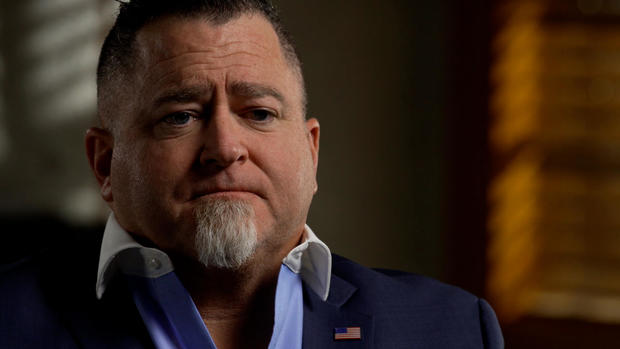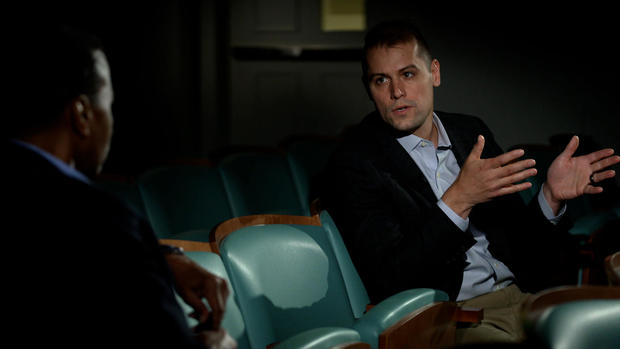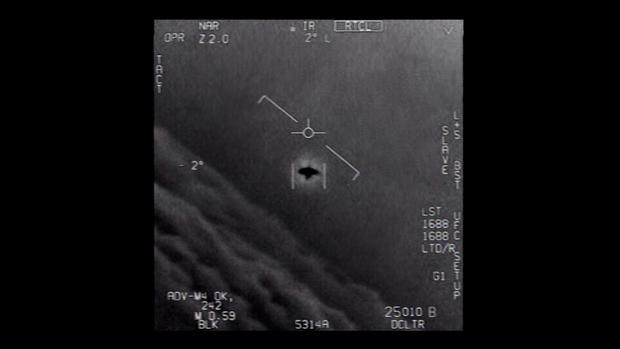UFOs regularly spotted in restricted U.S. airspace – 60 Minutes
Earlier this summer, the director of national intelligence and secretary of defense released a highly-anticipated, unclassified report about something the Pentagon calls unidentified aerial phenomena—or UAP—more commonly known as UFOs. The government’s grudging acknowledgment of 144 mysterious sightings documented by our military comes after decades of public denial. But as we first reported in May, whatever is trespassing in our skies and seas poses a serious safety risk to our servicemen and women, as well as our national security.
Bill Whitaker: So what you are telling me is that UFOs, unidentified flying objects, are real?
Lue Elizondo: Bill, I think we’re beyond that already. The government has already stated for the record that they’re real. I’m not telling you that. The United States government is telling you that.
Luis Elizondo spent 20 years running military intelligence operations worldwide: in Afghanistan, the Middle East and Guantanamo. He hadn’t given UFOs a second thought until 2008. That’s when he was asked to join something at the Pentagon called the Advanced Aerospace Threat Identification Program, or “AATIP.”
Lue Elizondo: The mission of AATIP was quite simple. It was to collect and analyze information involving anomalous aerial vehicles, what I guess in the vernacular you call them UFOs. We call them UAPs.
Bill Whitaker: You know how this sounds? It sounds nutty, wacky.
Lue Elizondo: Look, Bill, I’m not, I’m not telling you that, that it doesn’t sound wacky. What I’m telling you, it’s real. The question is, what is it? What are its intentions? What are its capabilities?
Buried away in the Pentagon, AATIP was part of a $22 million program sponsored by then-Senate Majority Leader Harry Reid to investigate UFOs. When Elizondo took over in 2010 he focused on the national security implications of unidentified aerial phenomena documented by U.S. service members.
Lue Elizondo: Imagine a technology that can do 6-to-700 g-forces, that can fly at 13,000 miles an hour, that can evade radar and that can fly through air and water and possibly space. And oh, by the way, has no obvious signs of propulsion, no wings, no control surfaces and yet still can defy the natural effects of Earth’s gravity. That’s precisely what we’re seeing.
Elizondo tells us AATIP was a loose-knit mix of scientists, electro-optical engineers, avionics and intelligence experts, often working part time. They combed through data and records, and analyzed videos like this.
A Navy aircrew struggles to lock onto a fast-moving object off the U.S. Atlantic Coast in 2015.
Recently released images may not convince ufo skeptics, but the pentagon admits it doesn’t know what in the world this is or this or this.
Bill Whitaker: So what do you say to the skeptics? It’s refracted light. Weather balloons. A rocket being launched. Venus.
Lue Elizondo: In some cases there are simple explanations for what people are witnessing. But there are some that, that are not. We’re not just simply jumping to a conclusion that’s saying, “Oh, that’s a UAP out there.” We’re going through our due diligence. Is it some sort of new type of cruise missile technology that China has developed? Is it some sort of high-altitude balloon that’s conducting reconnaissance? Ultimately when you have exhausted all those what ifs and you’re still left with the fact that this is in our airspace and it’s real, that’s when it becomes compelling, and that’s when it becomes problematic.
Former Navy pilot Lieutenant Ryan Graves calls whatever is out there a security risk. He told us his F/A-18F squadron began seeing UAPs hovering over restricted airspace southeast of Virginia Beach in 2014 when they updated their jet’s radar, making it possible to zero in with infrared targeting cameras.
Bill Whitaker: So you’re seeing it both with the radar and with the infrared. And that tells you that there is something out there?
Ryan Graves: Pretty hard to spoof that.
These photographs were taken in 2019 in the same area. The Pentagon confirms these are images of objects it can’t identify. Lieutenant Graves told us pilots training off the Atlantic Coast see things like that all the time.
Ryan Graves: Every day. Every day for at least a couple years.
Bill Whitaker: Wait a minute, every day for a couple of years?
Ryan Graves: Uh-huh.
Ryan Graves: I don’t see an exhaust plume.
Including this one – off the coast of Jacksonville, Florida in 2015, captured on a targeting camera by members of Graves’ squadron.
Soundbites from pilots: Look at that thing, it’s rotating! My gosh! They’re all going against the wind, the wind’s 120 knots to the west. Look at that thing dude!
Bill Whitaker: You can sorta hear the surprise in their voices.
Ryan Graves: You certainly can. They seem to have broke character a bit and were just kind of amazed at what they were seeing.
Bill Whitaker: What do you think when you see something like this?
Ryan Graves: This is a difficult one to explain. You have rotation, you have high altitudes. You have propulsion, right? I don’t know. I don’t know what it is, frankly.
He told us pilots speculate they are one of three things: secret U.S. technology, an adversary’s spy vehicle, or something otherworldly.
Ryan Graves: I would say, you know, the highest probability is it’s a threat observation program.
Bill Whitaker: Could it be Russian or Chinese technology?
Ryan Graves: I don’t see why not.
Bill Whitaker: Are you alarmed?
Ryan Graves: I am worried, frankly. You know, if these were tactical jets from another country that were hangin’ out up there, it would be a massive issue. But because it looks slightly different, we’re not willing to actually look at the problem in the face. We’re happy to just ignore the fact that these are out there, watching us every day.
The government has ignored it – at least publicly – since closing its project “Blue Book” investigation in 1969. But that began to change after an incident off Southern California in 2004, which was documented by radar, by camera, and four naval aviators. We spoke to two of them: David Fravor, a graduate of the Top Gun naval flight school and commander of the F/A-18F squadron on the USS Nimitz; and flying at his wing, Lieutenant Alex Dietrich, who has never spoken publicly about the encounter.
Alex Dietrich: I never wanted to be on national TV, no offense.
Bill Whitaker: So why are you doing this?
Alex Dietrich: Because I was in a government aircraft, because I was on the clock. And so I feel a responsibility to s– to share what I can. And it is unclassified.
It was November 2004 and the USS Nimitz carrier strike group was training about 100 miles southwest of San Diego. For a week, the advanced new radar on a nearby ship, the USS Princeton, had detected what operators called “multiple anomalous aerial vehicles” over the horizon, descending 80,000 feet in less than a second. On November 14, Fravor and Dietrich, each with a weapons systems officer in the backseat, were diverted to investigate. They found an area of roiling whitewater the size of a 737 in an otherwise calm, blue sea.
Dave Fravor: So as we’re looking at this, her back-seater says, “Hey, Skipper, do you…” And about that got out, I said, “Dude, do you, do you see that thing down there?” And we saw this little white Tic Tac-looking object. And it’s just kind of moving above the whitewater area.
As Deitrich circled above – Fravor went in for a closer look.
Bill Whitaker: So you’re sort of spiraling down?
Dave Fravor: Yep. The Tic Tac’s still pointing north-south, it goes, click, and just turns abruptly. And starts mirroring me. So as I’m coming down, it starts coming up.
Bill Whitaker: So it’s mimicking your moves?
Dave Fravor: Yeah, it was aware we were there.
He said it was about the size of his F/A-18F, with no markings, no wings, no exhaust plumes.
Dave Fravor: I want to see how close I can get. So I go like this. And it’s climbing still. And when it gets right in front of me, it just disappears.
Bill Whitaker: Disappears?
Dave Fravor: Disappears. Like, gone.
It had sped off.
Bill Whitaker: What are you thinking?
Alex Dietrich: So your mind tries to make sense of it. I’m gonna categorize this as maybe a helicopter or maybe a drone. And when it disappeared. I mean it was just…
Bill Whitaker: Did your back-seaters see this too?
Alex Dietrich: Yeah.
Dave Fravor: Oh yeah. There was four of us in the airplanes literally watching this thing for roughly about five minutes.
Seconds later, the Princeton reacquired the target. 60 miles away. Another crew managed to briefly lock onto it with a targeting camera before it zipped off again.
Alex Dietrich: You know, I think that over beers, we’ve sort of said, “Hey man, if I saw this solo, I don’t know that I would have come back and said anything,” because it sounds so crazy when I say it.
Bill Whitaker: You understand that reaction?
Dave Fravor: I do. I’ve had some people tell me, you know, “When you say that, you can sound crazy.” I’ll be hon– I’m not a UFO guy.
Bill Whitaker: But from what I hear you guys saying, there’s something?
Alex Dietrich: Yes.
Dave Fravor: Oh there’s, there’s definitely something that… I don’t know who’s building it, who’s got the technology, who’s got the brains. But there’s, there’s something out there that was better than our airplane.
The aircrew filed reports. Then like the mysterious flying object, the Nimitz encounter disappeared. Nothing was said or done officially for five years, until Lue Elizondo came across the story and investigated.
Lue Elizondo: We spend millions of dollars in training these pilots. And they are seeing something that they can’t explain. Furthermore, that informations being backed up on electro optical data, like gun camera footage. And by radar data. Now, to me, that’s compelling.
Inside the Pentagon his findings were met with skepticism. AATIP’s funding was eliminated in 2012, but Elizondo says he and a handful of others kept the mission alive until finally, frustrated, he quit the Pentagon in 2017, but not before getting these three videos declassified and then things took a stranger turn.
Chris Mellon: I tried to help my colleague, Lue Elizondo, elevate the issue in the department and actually get it to the Secretary of Defense.
Christopher Mellon served as deputy assistant secretary of defense for intelligence for Presidents Clinton and George W. Bush and had access to top secret government programs.
Chris Mellon: So it’s not us, that’s one thing we know.
Bill Whitaker: We know that?
Chris Mellon: I can say that with a very high degree of confidence in part because of the positions I held in the department, and I know the process.
Mellon says he grew concerned nothing was being done about UAPs, so he decided to do something. In 2017, as a private citizen, he surreptitiously acquired the three Navy videos Elizondo had declassified and leaked them to the New York Times.
Chris Mellon: It’s bizarre and unfortunate that someone like myself has to do something like that to get a national security issue like this on the agenda.
He joined forces with now civilian Lue Elizondo and they started to tell their story to anybody who would listen: to newspapers, the History Channel, to members of Congress.
Chris Mellon: We knew and understood that you had to go to the public, get the public interested to get Congress interested, to then circle back to the Defense Department and get them to start taking a look at it.
And now it is. Last year, the Pentagon resurrected AATIP, it’s now called the UAP task force; service members now are encouraged to report strange encounters; and the Senate wants answers.
Marco Rubio: Anything that enters an airspace that’s not supposed to be there is a threat.
After receiving classified briefings on UAPs, Senator Marco Rubio called for a detailed analysis. This past December, while he was still head of the intelligence committee, he asked the director of national intelligence and the Pentagon to present Congress an unclassified report.
Bill Whitaker: This is a bizarre issue. The Pentagon and other branches of the military have a long history of sort of dismissing this. What makes you think that this time’s gonna be different?
Marco Rubio: We’re gonna find out when we get that report. You know, there’s a stigma on Capitol Hill. I mean, some of my colleagues are very interested in this topic and some kinda, you know, giggle when you bring it up. But I don’t think we can allow the stigma to keep us from having an answer to a very fundamental question.
Bill Whitaker: What do you want us to do about this?
Marco Rubio: I want us to take it seriously and have a process to take it seriously. I want us to have a process to analyze the data every time it comes in. That there be a place where this is cataloged and constantly analyzed, until we get some answers. Maybe it has a very simple answer. Maybe it doesn’t.
A few weeks after our story aired, the director of national intelligence released an unclassified report saying UAP probably lack a single explanation, but that some “appear to demonstrate advanced technology,” meriting “further analysis.”
Produced by Graham Messick. Associate producer, Jack Weingart. Broadcast associate, Emilio Almonte. Edited by Craig Crawford.







